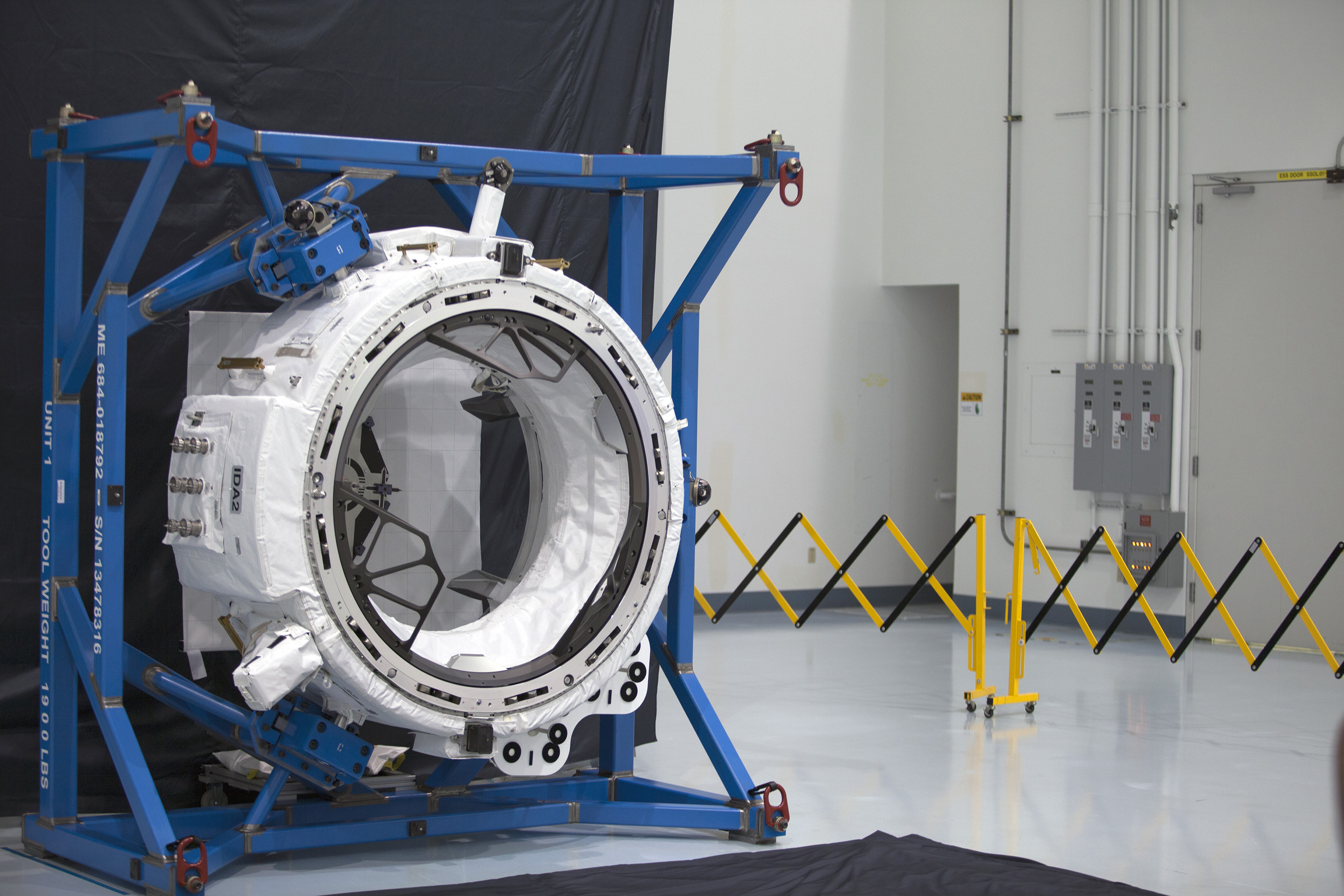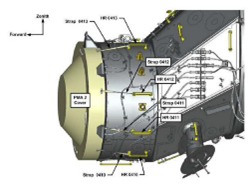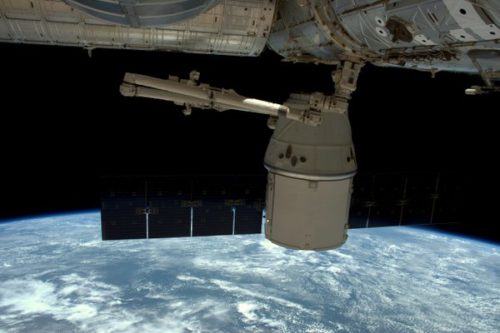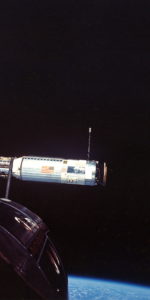
Forty-five minutes after midnight EDT on Monday, 18 July, SpaceX aims to deliver its 10th Dragon cargo ship toward the International Space Station (ISS). Conducted under the language of the initial $1.6 billion Commercial Resupply Services (CRS) contract with NASA, next week’s CRS-9 mission will follow on the heels of its eight predecessors and the Commercial Orbital Transportation Services (COTS) Demo of May 2012 and will mark the ninth overall Dragon to successfully reach the orbital outpost. Launching atop SpaceX’s Upgraded Falcon 9 booster from Space Launch Complex (SLC)-40 at Cape Canaveral Air Force Station, Fla., CRS-9 will be laden with a Boeing-built International Docking Adapter (IDA)—to be attached to the space station in support of NASA’s Commercial Crew ambitions—and a variety of critical research payloads and supplies for the incumbent Expedition 48 crew.
Earlier today (Wednesday), NASA and other officials gathered at the midpoint of the three-day ISS Research and Development Conference—hosted by the American Astronautical Society (AAS) and the Center for the Advancement of Science in Space (CASIS) in San Diego, Calif.—to discuss almost 4,900 pounds (2,220 kg) of payloads and hardware which will be delivered by CRS-9.
Unsurprisingly, a principal focus was upon IDA-2, which will form the primary docking adapter for Commercial Crew vehicles and will be installed onto Pressurized Mating Adapter (PMA)-2 at the forward “end” of the station’s Harmony node. In so doing, IDA-2 will replace the original IDA-1, which was destroyed last June when SpaceX’s CRS-7 cargo mission failed to achieve orbit. Two IDAs are needed to provide primary and backup docking interfaces for Boeing’s Starliner and SpaceX’s Crew Dragon piloted vehicles, although with IDA-2 now pushed into the “primary” role a replacement adapter is currently being fabricated as a new backup. IDA-3 has been assembled from around 300 already extant spares—representing about 70 percent of the whole—which enabled Boeing to press ahead rapidly with its construction. According to NASA ISS Program Manager Kirk Shireman, a precise date for the launch of IDA-3 has not been determined, although it may fly aboard SpaceX’s CRS-16 Dragon, which Novosti Kosmonavtiki places in summer 2018. However, he added that the program was “carrying the possibility” of launching IDA-3 sooner.

Mr. Shireman stressed that, as the first on-orbit element of the International Docking System Standard (IDSS), IDA-2 will serve as a trailblazer for future applications of these passive/active docking systems in low-Earth orbit and the cislunar environment. The IDSS was originally conceived as a means for connecting spacecraft from different nations—including the United States and its European, Japanese, and Canadian partners—whose complicating factors would be lessened by having an internationally accepted docking standard. Specifically, IDSS incorporates low-impact technology, capable of handling a wide range of contact and capture conditions.
With Boeing and SpaceX expected to launch their initial Starliner and Crew Dragon in an unpiloted capacity at some point in the fall of 2017, followed by crewed missions at some point thereafter, Mr. Shireman explained that there is “no requirement” for both primary and backup IDAs to be in place before the first Commercial Crew launch. In fact, both the unpiloted and inaugural crewed missions of Starliner and Crew Dragon—featuring NASA astronauts Sunita Williams, Eric Boe, Doug Hurley, and former Chief Astronaut Bob Behnken—will all dock at the IDA-2 interface on Harmony’s forward end.
It is anticipated that most Commercial Crew missions will follow an “indirect handover” protocol, in a manner not dissimilar to current Soyuz operations, whereby a given vehicle departs and a replacement arrives a few days later. However, Mr. Shireman highlighted that NASA is protecting for “direct” handovers, in which incoming and outgoing crews will see each other for a few days of changeover. All told, he anticipates Commercial Crew visitors to follow a similar traffic model to current cargo operations with Orbital ATK’s Cygnus, SpaceX’s Dragon, and Japan’s H-II Transfer Vehicle (HTV), which saw a period of “dual-berthed” activities for the first time in April 2016. Asked about any elevated tension as he watches IDA-2 rise from Earth, Mr. Shireman noted that his NASA career started only months before the loss of Challenger. Although he feels “no additional pressure,” and sees IDA-2 as no more important as the other science aboard CRS-9, he admitted that he will be “sweating bullets” as he watches the Upgraded Falcon 9 head into orbit.
And the science aboard CRS-9, though overshadowed by the presence of IDA-2, is significant and far-reaching. According to Camille Alleyne, associate ISS Program Scientist at NASA’s Johnson Space Center (JSC) in Houston, Texas, around 2,200 pounds (1,000 kg) of the Dragon’s pressurized cargo will support 280 new and ongoing investigations being performed by the incumbent Expedition 48 crew, headed by Commander Jeff Williams, and, from September, by the Expedition 49 crew, led by Commander Anatoli Ivanishin.

Efforts to further stem-cell research, with particular relevance for cardiac repair, as well as investigations into changes within the human heart in space, form one research thrust. Elsewhere, Expedition 48/49 crew member Kate Rubins is involved in the development of the Biomolecule Sequencer. About half the size of an average smartphone, the latter is designed to demonstrate that DNA sequencing is feasible in an orbiting spacecraft, perhaps leading to future efforts which could diagnose diseases and understand astronaut health issues in deep space. Although it was originally conceived to include extreme and bizarre samples, such as “extremophiles,” it was ultimately decided by the research team to utilize DNA from viruses, bacteria, and a mouse, thereby offering samples with well-known genetic structures. In the words of JSC microbiologist Sarah Wallace, the presence of an on-board DNA sequencer could prove “a game-changer” and, in the future, could lead to methods for identifying life deep in the Solar System.
Bruce Hammer of the University of Minnesota discussed his “OsteoOmics” investigation—a portmanteau of “osteoporosis” and “genomics”—which seeks to explore the effects of microgravity upon bone cell function. Specifically, the experiment will explore the molecular mechanisms behind this bone loss by examining bone-forming osteoblasts and bone-dissolving osteoclasts, thereby offering insights which may counteract bone loss during future space missions. Moreover, such research could provide invaluable insights into preventing and treating bone diseases such as osteopenia and osteoporosis on Earth.
Describing the Phase Change Material Heat Exchanger (PCM-HX), Lanetra Tate of NASA’s Game-Changing Development Program highlighted a device which will use wax-based products in place of water or ammonia consumables for heat rejection. She anticipates that the PCM-HX will be put through about 100 freeze/thaw cycles, each lasting about 180 minutes, and, if successful, the program will move to 1,000 cycles thereafter.
According to current plans, CRS-9 will launch at 12:45 a.m. EDT on Monday, 18 July, with a backup date of Wednesday, 20 July, secured with the Eastern Range, in the event of a launch scrub. An on-time launch in the opening hours of Monday morning in Florida will deliver the Dragon into the vicinity of the space station about two days later. Capture and berthing of the cargo ship will be overseen by Expedition 48 Commander Jeff Williams, supported within the multi-windowed cupola by Kate Rubins.
Demonstrating an improved method of conserving crew time for research, the astronauts will return to their scientific work immediately after Dragon is captured, with Mission Control orchestrating the physical berthing and activation of latches to secure the cargo ship in place at the Earth-facing (or “nadir”) port of the Harmony node. Cargo removal will occupy several weeks, with IDA-2 expected to be robotically removed from Dragon’s unpressurized “trunk”—by means of the 57.7-foot-long (17.6-meter) Canadarm2 robotic arm—at some point in early August. An EVA by Williams and Rubins in the third week of August will then install IDA-2 to its permanent home at the forward end of Harmony.
Want to keep up-to-date with all things space? Be sure to “Like” AmericaSpace on Facebook and follow us on Twitter: @AmericaSpace
Missions » ISS » COTS » CRS-9 »





Thank you for the informative CRS-9 Dragon, IDA-2, and ISS update Ben!
“It is anticipated that most Commercial Crew missions will follow an “indirect handover” protocol, in a manner not dissimilar to current Soyuz operations, whereby a given vehicle departs and a replacement arrives a few days later. However, Mr. Shireman highlighted that NASA is protecting for “direct” handovers, in which incoming and outgoing crews will see each other for a few days of changeover”
NASA recently issued a RFI for a commercial habitat to dock with an ISS port.
http://spacenews.com/nasa-seeking-ideas-for-use-of-space-station-docking-port/
If a commercial Habitat can be operational after the Bigelow BEAM test article is gone, it would allow for direct handovers. Having an extra 4 bodies on the ISS for a couple days could be a boon for getting a lot of work done.
Vladislaw –
“Bigelow said after the panel session that Bigelow was still in discussions with NASA about installing a B330 on the station. ‘We have made a formal proposal to do that,’ he said. ‘We would be really excited to do that with NASA, and we gave them a tremendous deal.'”
From the article you noted: ‘NASA seeking ideas for use of space station docking port’
By Jeff Foust July 15, 2016 At: http://spacenews.com/nasa-seeking-ideas-for-use-of-space-station-docking-port/
Note also:
“Bigelow Aerospace will loft its giant, expandable B330 modules — each of which will provide one-third as much usable volume as the entire International Space Station (ISS) — aboard United Launch Alliance (ULA) Atlas V rockets, representatives from both companies announced today (April 11).”
And, “Two B330s should be ready to go by 2020, and the goal is to launch at least one of the modules that year.”
From: ‘Private Space Habitat to Launch in 2020 Under Commercial Spaceflight Deal’
By Mike Wall April 11, 2016 At: http://www.space.com/32541-private-space-habitat-launching-2020.html
“The exterior of the craft is intended to be 13.7 metres (45 ft) long by 6.7 metres (22 ft) in diameter[6] and the module will weigh between 20,000 kilograms (45,000 lb) and 23,000 kilograms (50,000 lb).”
And “The habitat is designed to have two solar arrays and two thermal radiator arrays for heat dissipation, as well as life support systems to sustain a crew of up to six astronauts.”
From: ‘B330’ Wikipedia
Would the exterior size, internal volume, mass, or other aspects of the large B330 habitat create any new issues for controlling or using the “419,455 kg (924,740 lb)” and pressurized “volume” of “931.57 m3 (32,898 cu ft)” of the International Space Station?
Quoted mass and volume from: ‘International Space Station’ at Wikipedia
Could a second B330 habitat eventually be permanently docked to the initial B330 habitat that docked to the ISS without the second B330 habitat raising any major issues?
Could enough additional Soyuz spacecraft, Dragon 2s, or CST-100 Starliners be docked to the International Space Station to provide sufficient emergency evacuation to Earth seats for everyone including all the potential additional crew members of one or two B330 habitats?
Would having one or two B330 habitats attached to the ISS lower the spaceflight mission risks for the B330 astronauts compared to the flight risks of a free flying B330 or a free flying docked together pair of B330 habitats?
Yep, if the logistics and other issues could be worked out, “Having an extra 4” to 12 “bodies on the ISS for a couple days” or months “could be a boon for getting a lot of work done.”